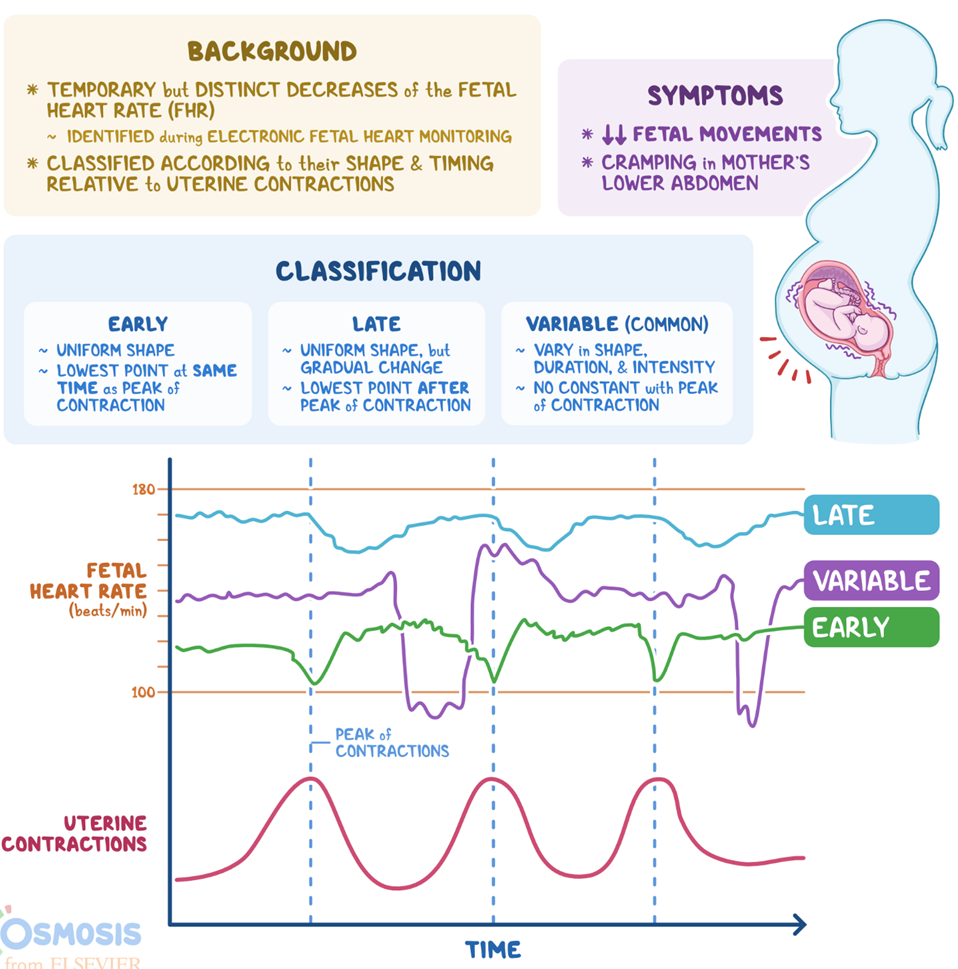A nurse is observing the electronic fetal heart rate monitor tracing for a client who is at 40 weeks of gestation and is in labor. The nurse should suspect a problem with the umbilical cord when she observes which of the following patterns?
Accelerations
Early decelerations
Late decelerations
Variable decelerations
The Correct Answer is D
The correct answer is D. Variable decelerations.
A. Accelerations in the fetal heart rate are generally considered reassuring. Accelerations are an indication of fetal well-being and are often seen in response to fetal movement.
B. Early decelerations are typically associated with head compression during contractions and are considered a normal response to the pressure on the fetal head.
C. Late decelerations are indicative of uteroplacental insufficiency.
Late decelerations occur after the peak of the contraction and are associated with inadequate oxygenation to the fetus. This pattern raises concerns about the baby's well-being.
D. Variable decelerations are associated with umbilical cord compression.
Variable decelerations are abrupt decreases in the fetal heart rate that vary in duration, depth, and timing. They often coincide with contractions and suggest compression or occlusion of the umbilical cord.

Nursing Test Bank
Naxlex Comprehensive Predictor Exams
Related Questions
Correct Answer is B
Explanation
The correct answer is B.
A. Place warm, moist packs on the breasts: Warm, moist packs can increase blood flow and may actually stimulate milk production. This is not an appropriate intervention for lactation suppression.
B. Apply cabbage leaves to the breasts: This is the correct intervention. Cabbage leaves have been traditionally used to help reduce engorgement and suppress lactation. The mechanism is not fully understood, but it is believed that compounds in cabbage may help decrease milk supply.
C. Wear a loose-fitting bra: Wearing a loose-fitting bra can help reduce friction and discomfort, but it is not a specific intervention for lactation suppression.
D. Put green teabags on the breast: Green teabags are not commonly recommended for lactation suppression. Cabbage leaves are more widely accepted for this purpose.
Correct Answer is A
Explanation
A. "This medication promotes softening of the cervix."
A. Dinoprostone is a prostaglandin E2 analogue that is used to ripen the cervix by promoting softening and effacement. This is an important step in preparing the cervix for labor induction or augmentation.
B. Dinoprostone does not cause relaxation of the uterine muscles. Instead, it specifically works on the cervix to make it more favorable for labor.
C. Dinoprostone is not used to treat preeclampsi
A. It is primarily used for cervical ripening in the context of labor induction or augmentation.
D. Dinoprostone is not used to treat genital herpes simplex virus. It is specifically employed for its effects on cervical ripening and preparing the cervix for labor.
Whether you are a student looking to ace your exams or a practicing nurse seeking to enhance your expertise , our nursing education contents will empower you with the confidence and competence to make a difference in the lives of patients and become a respected leader in the healthcare field.
Visit Naxlex, invest in your future and unlock endless possibilities with our unparalleled nursing education contents today
Report Wrong Answer on the Current Question
Do you disagree with the answer? If yes, what is your expected answer? Explain.
Kindly be descriptive with the issue you are facing.
